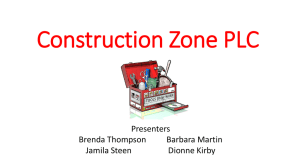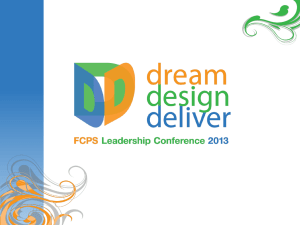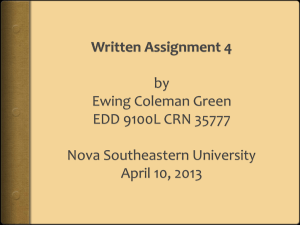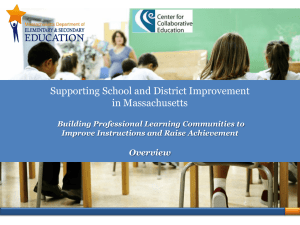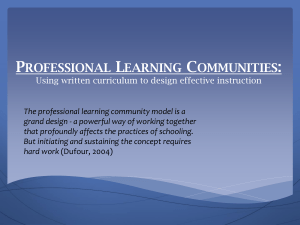Using Professional Learning Communities to Address the
advertisement
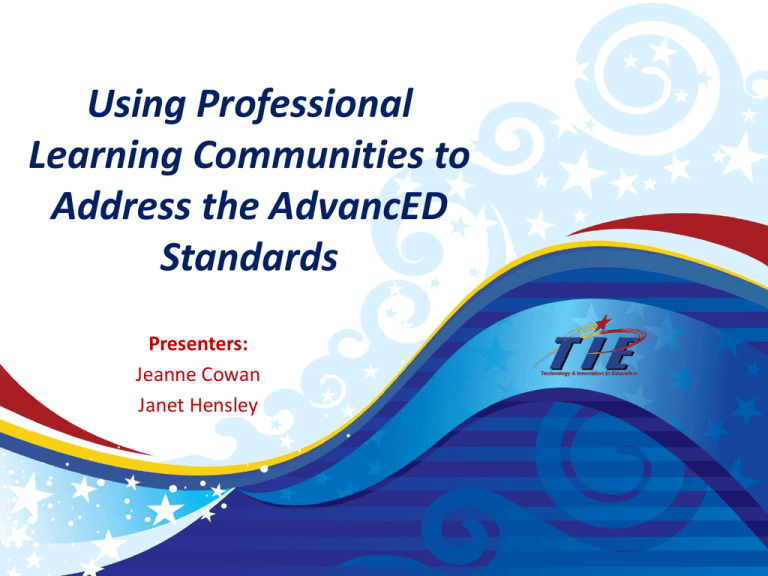
Using Professional Learning Communities to Address the AdvancED Standards Presenters: Jeanne Cowan Janet Hensley Outcomes • To become familiar with the Professional Learning Communities (PLC) model • To enhance your understanding of how a PLC provides the structure for a “systems approach” to school improvement by concentrating on interdependent relationships • To learn how collaborative teams can help us focus on the continuous improvement of the entire organization while addressing the AdvancED Standards and Indicators. Professional Learning Communities & AdvancED • The Professional Learning Communities (PLC) model is designed to improve teaching and learning. • A PLC provides the structure for a “systems approach” to school improvement by concentrating on interdependent relationships. • Collaborative teams focus on the continuous improvement of the entire organization while addressing each of the AdvancED Standards and many of the Indicators. 6 Characteristics of PLCs 1) Shared Mission, Vision, Values and Goals—All Focused on Student Learning 2) A Collaborative Culture With a Focus on Learning 3) Collective Inquiry Into Best Practice 4) Action Orientation: Learning by Doing 5) A Commitment to Continuous Improvement 6) Results Orientation 5 AdvancED Standards 1) 2) 3) 4) 5) Purpose and Direction Governance and Leadership Teaching and Assessing for Learning Resources and Support Systems Using Results for Continuous Improvement Shared Mission, Vision, Values and Goals—All Focused on Student Learning The very essence of a learning community is a focus on and a commitment to the learning of each student. • What AdvancED Standard(s) does this align with? • What indicators seem to correlate with this PLC characteristic? A Collaborative Culture With a Focus on Learning A PLC is composed of collaborative teams whose members work interdependently to achieve common goals linked to the purpose of learning for all. • What AdvancED Standard(s) does this align with? • What indicators seem to correlate with this PLC characteristic? Collective Inquiry Into Best Practice The teams in a PLC engage in collective inquiry into both best practices in teaching and best practices in learning. • What AdvancED Standard(s) does this align with? • What indicators seem to correlate with this PLC characteristic? Action Orientation: Learning by Doing Members of PLCs are action oriented: They move quickly to turn aspirations into action and visions into reality. • What AdvancED Standard(s) does this align with? • What indicators seem to correlate with this PLC characteristic? A Commitment to Continuous Improvement Inherent to a PLC are a persistent disquiet with the status quo and a constant search for a better way to achieve goals and accomplish the purpose of the organization. • What AdvancED Standard(s) does this align with? • What indicators seem to correlate with this PLC characteristic? Results Orientation Members of a PLC realize that all of their efforts must be assessed on the basis of measureable results rather than intentions. • What AdvancED Standard(s) does this align with? • What indicators seem to correlate with this PLC characteristic? PLC OVERVIEW Professional Learning Communities • What is a professional learning community? • What are the implications for AdvancED schools? PLC Defined A Professional Learning Community (PLC) is an ongoing process in which educators work collaboratively in recurring cycles of collective inquiry and action research to achieve better results for the students they serve. Learning By Doing, 2010 The Big Arrow Aim of the District District Goals & Measures Random Acts of Improvement The Better Big Arrow Aim of the District District Goals & Measures Aligned Acts of Improvement A PLC is NOT… • A program • Something you can purchase • A meeting on Tuesdays • A PLC is not a meeting; it is a way being. • A school does not do PLCs; they become a PLC. “Big Ideas” of a PLC • Focus on student learning rather than teaching. • Work collaboratively on matters related to learning. • Hold everyone accountable for the results that fuel continual improvement. Four Key Questions 1. What is it we expect our students to learn? (standards) 2. How will we know when they have learned it? (evidence, assessments) 3. How will we respond when they don’t learn? (interventions—time and support) 4. How will we respond when they already know it? (differentiation) Advantages of Teachers Working in Teams Develop more creative solutions to complex problems Reduce isolation among teachers Build commitment and support for new ideas Foster collective responsibility for students’ success Successfully implement complex plans Allow those closest to the work to collectively improve teaching and learning Provide possibilities for empowerment that are not available for individuals One model of the BLT Team Process This could be the same group as your AdvancED Leadership Team. 1. The BLT (Building Leadership Team) meets regularly and also prior to each scheduled in-service. 2. At each BLT meeting, discussion is held regarding strategies to meet district-wide goals or to plan in-service sessions. 3. The BLT Team takes the information identified at its meeting and plans the best way to introduce and share the information with their whole instuctional staff (may be building specific). Structures for Teams Horizontal groups by grade level Vertical teams by subject area Interdisciplinary groups Groups with common planning times Groups formed around AdvancED goals, standards and/or indicators Personal interest in working on a particular goal or topic Others Collaborative Teams “Hardware” and “Software” Hardware: Software: • Form a leadership team • Organize instructional staff into collaborative teams • Arrange regular meeting times with agendas and shared minutes • Focus on goals with results for improving student achievement • Create norms • Develop collaboration skills • Learn to deal with “resistors” • Celebrate learning with one another! The PLC Journey Begins… What is it that we must do as a “systems team” in order to work collaboratively and efficiently as a Professional Learning Community? P (Professional) L (Learning) C (Community) Ideas for Setting Up Your PLC • What—share PLC concept with staff • How—presentation, e-mail from principal and leadership team • Who—all instructional staff are on a team • When—this semester, next semester; meeting times • Where--staff meeting, in-service day Getting Started… Helpful Resources: • • • • • Revisiting Professional Learning Communities at Work (DuFour) Learning by Doing (DuFour) Raising the Bar and Closing the Gap, Whatever it Takes (DuFour) Aligning School Districts as PLCs (Mark Van Clay, Soldwedel, Many) Building a Professional Learning Community at Work (Graham and Ferriter) This website has practical ideas and reproducibles: www.allthingsplc.com http://pirll.tie.wikispaces.net/AdvancED+handouts Getting Started… Self-Assessment Where do we go from here? • What are some first step(s) that your school can take to implement a PLC? Getting Started… Where Do We Go From Here? Where do we go from here? • What are the first step(s) that we must take to structure or school as a PLC? • Who will be responsible for initiating this? • What is a realistic timeline for this? Professional Learning Community Taking ACTION “Perhaps the greatest insight we have gained in our work with school districts across the continent is that schools that take the plunge and actually begin doing the work of a PLC develop their capacity to help students learn at high levels far more effectively than schools that spend years preparing to become PLCs through reading or even training.” Richard DuFour, et. al. Learning by Doing Thanks for coming today! Good luck on your PLC Journey! http://pirll.tie.wikispaces.net/AdvancED+handouts
